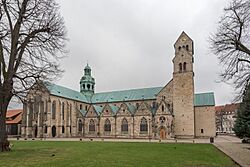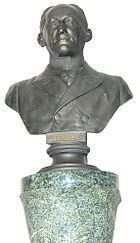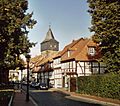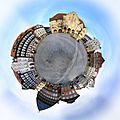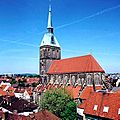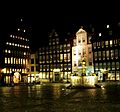Hildesheim facts for kids
Quick facts for kids
Hildesheim
|
|||
|---|---|---|---|
|
Clockwise from top: St. Mary's Cathedral (UNESCO World Heritage Site), half-timbered houses at the Brühl street, St. Andrews Church, St. Michael's Church (UNESCO World Heritage Site), Roemer- und Pelizaeus-Museum and the Historic Market Place
|
|||
|
|||
| Country | Germany | ||
| State | Lower Saxony | ||
| District | Hildesheim | ||
| Elevation | 81 m (266 ft) | ||
| Population
(2022-12-31)
|
|||
| • Total | 101,858 | ||
| Time zone | CET/CEST (UTC+1/+2) | ||
| Postal codes |
31134–31141
|
||
| Dialling codes | 05121 | ||
| Vehicle registration | HI, ALF | ||
| Website | www.hildesheim.de | ||
| UNESCO World Heritage Site | |
|---|---|
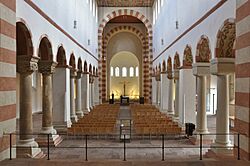
Ottonian architecture in St. Michael's Church
|
|
| Criteria | Cultural: i, ii, iii |
| Inscription | 1987 (11th Session) |
| Area | 0.58 ha |
| Buffer zone | 157.68 ha |
Hildesheim is a city in Lower Saxony, a state in north-central Germany. It has about 101,000 people living there. The city is located in the Hildesheim district, about 30 kilometers (19 miles) southeast of Hanover. It sits on the banks of the Innerste River, which is a small branch of the Leine River.
The Holy Roman Emperor Louis the Pious started the Bishopric of Hildesheim in the year 815. He also created the first small settlement with a chapel on a hill called Domhügel.
Hildesheim is connected to major roads, including the Autobahn 7. This highway links it to Hamburg in the north and Austria in the south.
Two important buildings in Hildesheim, the Hildesheim Cathedral and the St. Michael's Church, became UNESCO World Heritage Sites in 1985. This means they are very special and important places for the whole world. In 2015, the city and its diocese (a church area) celebrated their 1200th birthday!
Contents
History of Hildesheim
How Hildesheim Began
People say the city got its name from its founder, Hildwin. Hildesheim is one of the oldest cities in Northern Germany. It became the main place for the Bishopric of Hildesheim in 815. It might have started when the bishop moved from Elze to a crossing point over the River Innerste. This spot was an important market on the Hellweg trade route.
The area around the cathedral quickly grew into a town. In 983, King Otto III gave it the right to hold a market. The first market was on a street still called Alter Markt (Old Market). Later, as the city grew, a bigger market square was needed. The current market square was created in the early 1200s, when Hildesheim had about 5,000 people.
Hildesheim in the Middle Ages
Hildesheim became an official city in 1249. At that time, it was one of the largest cities in Northern Germany. For 400 years, church leaders ruled Hildesheim. Then, a Town Hall was built, and citizens started to have more say and independence. The building of the current Town Hall began in 1268. In 1367, Hildesheim joined the Hanseatic League, a powerful group of trading cities.
Changes and Wars
In 1542, most people in Hildesheim became Lutheran (Protestant). Only the cathedral and a few other buildings stayed under Roman Catholic control. Some villages nearby also remained Catholic.
During the Thirty Years' War, Hildesheim was attacked and taken over several times. This happened in 1628 and 1632 by imperial troops, and in 1634 by troops from other German regions.
Hildesheim in the 1800s
After the Napoleonic Wars in 1813, Hildesheim became part of the Kingdom of Hanover. Later, in 1866, it became a province of the Kingdom of Prussia. In 1868, soldiers found a very valuable collection of about 70 Roman silver dishes and cups. This discovery is known as the Hildesheim Treasure.
World War II and Rebuilding
During World War II, Hildesheim was heavily damaged by British air raids in 1945. The worst attack was on March 22. Even though Hildesheim was not a major military target, the historic city was bombed to lower the spirits of German civilians.
About 29% of the houses were completely destroyed, and 45% were damaged. Only 26% of the houses remained untouched. The city center, which had kept its old medieval look, was almost completely flattened. Before the war, there were about 800 half-timbered houses, but only around 200 survived.
After the war, people focused on building new homes quickly. Modern concrete buildings replaced many of the destroyed historic ones. However, most of the important churches, including the two UNESCO World Heritage sites, were rebuilt to look like their original style soon after the war.
Modern Hildesheim
In 1978, the University of Hildesheim was started. In the 1980s, efforts began to rebuild the historic city center. Some of the less attractive concrete buildings around the market square were taken down. They were replaced with copies of the original historic buildings. In 2007, it was decided to rebuild the Umgestülpter Zuckerhut (Upended Sugarloaf). This is a famous half-timbered house known for its unusual shape. In 2015, the city and its diocese celebrated their 1200th anniversary.
Religions in Hildesheim
In 1542, most people in Hildesheim became Lutherans. Today, about 28.5% of people are Roman Catholics. About 38.3% are Protestants. The remaining 33% follow other religions or do not have a religion.
Main Sights to See
- The Marktplatz (historic market place) was rebuilt between 1984 and 1990. It was destroyed in the 1945 air raid. Important buildings in the square include:
- The Knochenhaueramtshaus (Butchers' Guild Hall): This building was first built in 1529. It was destroyed in 1945 and rebuilt from 1987 to 1989. Its front is beautifully decorated with colorful paintings. Today, it has a restaurant and the City Museum.
- The Bäckeramtshaus (Bakers' Guild Hall): This half-timbered house was originally built in 1825. It was rebuilt after being destroyed in 1945. Now, it is a café.
- The Town Hall: Built in the 13th century in a Gothic style. It was partly destroyed in 1945 but rebuilt and opened again in 1954.
- The Tempelhaus: A 14th-century house that now holds the tourist information office. It was damaged in World War II but fixed by 1950.
- The Wedekindhaus: A 16th-century house known for its tall, beautifully carved floors.
- The Romanesque St. Mary's Cathedral: This cathedral has ancient bronze doors (called Bernward Doors) from around 1015 and other valuable items. The cathedral was built in the 9th century. It was almost completely destroyed in 1945 but rebuilt quickly. It has been a UNESCO World Heritage Site since 1985. A famous dog rose bush, supposedly 1,000 years old, still grows on the wall of the cathedral.
- Museum of the Cathedral: Here you can see the Cathedral Treasure.
- St. Michael's Church: This is another UNESCO World Heritage Site. It is an early Romanesque church in Germany and a great example of Ottonian architecture. It was built from 1010 to 1022.
- The St. Andreas (St. Andrew's Church): A 12th-century Gothic church with the tallest church steeple (114.5 meters or 376 feet) in Lower Saxony. Across from the church is the Upended Sugarloaf, a unique half-timbered house from 1509.
- The Roemer-und-Pelizaeus-Museum: This museum has collections from ancient Egypt and Peru. It also hosts special exhibitions.
- The Kreuzkirche (Church of the Holy Cross): This church was once part of the city's medieval defenses. It became a church around 1079. It was badly damaged in 1945 and rebuilt.
- The Romanesque Basilica Minor of St. Godehard (St. Gotthard's Church): Built from 1133 to 1172. It is expected to become a UNESCO World Heritage Site soon.
- The Kehrwiederturm (Kehrwieder Tower): Built around 1300, this is the only remaining tower from the city's medieval walls.
- Half-timbered houses: Many old half-timbered houses that were not destroyed in World War II can be seen around St. Godehard and the Kehrwieder Tower. You can find them on streets like Keßlerstraße, Knollenstraße, Gelber Stern, Am Kehrwieder, Lappenberg, Brühl, Hinterer Brühl, and Godehardsplatz. Some have beautiful wood carvings on their fronts.
- The church St. Jacobi (St. James' Church): This 500-year-old Gothic church was a pilgrim church on St. James's Path. Today, it is a cultural church focusing on literature.
- The Monument of the Synagogue: This monument was built in 1988 in the old Jewish quarter. It shows the foundations of the synagogue that was destroyed in 1938.
- Mauritiuskirche (St. Maurice's Church): An 11th-century Romanesque church on a hill in the west of the city. It has a cloister (a covered walkway).
- Kaiserhaus (Emperor's House): A Renaissance building from 1586 in Alter Markt, the oldest street in Hildesheim. It was rebuilt after the war.
- The Alte Kemenate: A medieval storehouse from the 15th century, one of the oldest non-religious buildings in Hildesheim. It was damaged but repaired after the war.
- St Magdalena's Church (Magdalenenkirche): A small church with large windows, started in 1224. It was originally Romanesque but changed to Gothic in 1456.
- Magdalenengarten: A beautiful Baroque park created between 1720 and 1725, near St. Magdalena's Church. It has many types of roses, a rose museum, and even a small vineyard.
- St. Bernward's Church: A church built from 1905 to 1907, destroyed in 1945, and rebuilt from 1948 to 1949.
- Steuerwald Castle (Burg Steuerwald): Located north of the city, about 3 kilometers (1.9 miles) from the Market Place. It was built from 1310 to 1313.
- Marienburg Castle (Burg Marienburg): Located southeast of Hildesheim, about 6 kilometers (3.7 miles) from the Market Place. It was built from 1346 to 1349.
- Marienrode Priory (Kloster Marienrode): Located southwest of Hildesheim, about 6 kilometers (3.7 miles) from the Market Place. It was founded in 1125. The church was built in Gothic style and completed in 1462.
Other interesting places include the theatre, which offers opera, musicals, plays, ballet, and concerts.
Population of Hildesheim
On December 31, 2017, Hildesheim had 103,970 residents.
| Historical population | ||
|---|---|---|
| Year | Pop. | ±% |
| 1400 | 6,000 | — |
| 1450 | 8,000 | +33.3% |
| 1648 | 5,500 | −31.2% |
| 1803 | 11,108 | +102.0% |
| 1825 | 12,630 | +13.7% |
| 1849 | 14,651 | +16.0% |
| 1871 | 20,801 | +42.0% |
| 1875 | 22,581 | +8.6% |
| 1890 | 33,481 | +48.3% |
| 1900 | 42,973 | +28.4% |
| 1910 | 50,239 | +16.9% |
| 1919 | 53,499 | +6.5% |
| 1925 | 58,522 | +9.4% |
| 1933 | 62,519 | +6.8% |
| 1939 | 72,101 | +15.3% |
| 1950 | 65,531 | −9.1% |
| 1961 | 96,296 | +46.9% |
| 1970 | 93,400 | −3.0% |
| 1975 | 106,000 | +13.5% |
| 1980 | 102,700 | −3.1% |
| 1985 | 100,900 | −1.8% |
| 1989 | 103,512 | +2.6% |
| 1997 | 105,700 | +2.1% |
| 2002 | 103,448 | −2.1% |
| 2013 | 100,708 | −2.6% |
| 2015 | 101,667 | +1.0% |
| 2017 | 103,970 | +2.3% |
| 2019 | 101,693 | −2.2% |
Who Leads Hildesheim?
The current mayor of Hildesheim is Dr. Ingo Meyer. He has been the mayor since 2014.
Twin Towns and Sister Cities
Hildesheim is connected to other cities around the world as "twin towns" or "sister cities":
 Angoulême, France (since 1965)
Angoulême, France (since 1965) Minya, Egypt (since 1975)
Minya, Egypt (since 1975) Weston-super-Mare, England, United Kingdom (since 1983)
Weston-super-Mare, England, United Kingdom (since 1983) Gelendzhik, Russia (since 1992)
Gelendzhik, Russia (since 1992) North Somerset, England, United Kingdom (since 1997)
North Somerset, England, United Kingdom (since 1997) Pavia, Italy (since 2000)
Pavia, Italy (since 2000)
Fun Events in Hildesheim
- M'era Luna Festival: This is a very important festival for fans of gothic and wave music in Europe.
- "Jazztime" festival: A jazz music festival held on the weekend of Pentecost (usually in May or June).
Economy and Businesses
Some important companies in Hildesheim include:
- Robert Bosch Car Multimedia
- St. Bernward Hospital
- Helios Hospital
- Sparkasse Hildesheim
- KSM Castings Group
- Petrofer Chemie H. R.
- Optimal Personal & Organisation
- Medifox DAN
- Howmet Aerospace
Getting Around Hildesheim
Hildesheim has good ways to get around. It's a main spot for national roads and trains (Hildesheim Hauptbahnhof has fast InterCityExpress services). It's also connected to the motorway (Autobahn), has a harbor on the Mittellandkanal (a canal), and a local airfield.
Schools and Learning
Hildesheim has many secondary schools, including different types of high schools like Gymnasiums and comprehensive schools. Some examples are Gymnasium Andreanum and Gymnasium Marienschule.
For higher education, students can attend the University of Hildesheim or the Hochschule für angewandte Wissenschaft und Kunst (HAWK).
Culture
The city is home to the main office of the Serbian Orthodox Eparchy of Frankfurt and all of Germany.
Famous People from Hildesheim
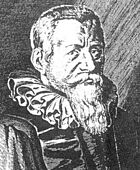

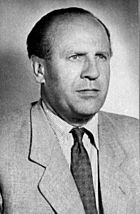
Many interesting people have connections to Hildesheim:
- Gotthard of Hildesheim (960–1038): A Roman Catholic saint.
- Bernward of Hildesheim (960–1022): A famous Bishop of Hildesheim.
- John of Hildesheim (around 1310–1375): A Carmelite friar and writer.
- Frederick Hornemann (1772–1801): A German explorer of Africa.
- Ferdinand von Roemer (1818–1891): A well-known geologist.
- Erich Pommer (1889–1966): A famous film producer.
- Adolf Hurwitz (1859–1919): A mathematician who worked on algebra and geometry.
- Heinrich Nordhoff (1899–1968): An engineer who was the Chairman of Volkswagen and important for the VW Beetle car.
- Sir Hans Adolf Krebs (1900–1981): A doctor and biochemist who won the Nobel Prize in 1953.
- Oskar Schindler (1908–1974): A German businessman famous for saving many lives during World War II. His story was told in the book Schindler's Ark and the film Schindler's List.
- Rudolf Schenker (born 1948): A guitarist and founder of the hard rock band Scorpions.
- Michael Schenker (born 1955): Another German rock guitarist, also a founding member of the Scorpions.
- Thomas Quasthoff (born 1959): A famous German bass-baritone singer.
- Wolfgang and Christoph Lauenstein (born 1962): Twin brothers who won an Academy Award in 1989 for their animated film Balance.
- Diane Kruger (born 1976): A supermodel and actress, known for playing Helen in the film Troy.
- Sara Harstick (born 1981): A freestyle swimmer who won bronze medals at the 2000 and 2004 Summer Olympics.
Images for kids
-
St. Michael's Church, a UNESCO World Heritage site
-
Abbey of the Dormition of the Theotokos
See also
 In Spanish: Hildesheim para niños
In Spanish: Hildesheim para niños


